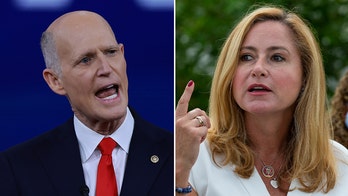“I used to do a little. But a little wouldn’t do. So the little got more and more.”
- Lyrics from the song Mr. Brownstone by Guns N’ Roses, about heroin addiction.
The crush of protesters who flooded the National Mall and lined the West Front of the Capitol over the weekend were boiling. They were steaming about the growth of government and what they contend is an overreach into their daily lives. Last fall’s $700 billion rescue plan to salvage struggling financial institutions. A bailout of Bear Stearns. Boosts for Citigroup, Bank of America and AIG. Then President Obama’s mammoth stimulus package. Government seizing the helm of General Motors. The House’s approval of the “cap and trade” climate bill. The creation of dozens of government czars. And on the marquee now, Mr. Obama’s health care plan.
So the outrage simmers over the explosion of government influence.
Big government isn’t new. It’s now “too big to fail,” growing exponentially. And if the protesters, Tea Party loyalists and others angry about the spike in the size of government wanted to know where this trend started, they came to the right place. For the very infrastructure of Capitol Hill is an emblem to the expansion of government over the decades.
Perhaps the best place to start is in the Capitol itself, in the old House chamber (note that the Capitol nearly doubled in size in mid 19th Century as workers added House and Senate wings to the building). Now known as Statuary Hall, square, brass plates dot the floor of the former House chamber. Each plate denotes the desk locations of House Members who also became President of the United States. At one end of the room, tourists shuffle over the plate marking where President James Polk held forth. Before his election to the White House, Polk was a Congressman from Tennessee and even became Speaker of the House.
On the other end of the room, there’s a plate for President John Quincy Adams, who represented Massachusetts in the House AFTER he left the presidency. Floor plates also note the desk locations of Presidents John Tyler, Franklin Pierce, Millard Fillmore, Andrew Johnson, James Buchanan and Abraham Lincoln.
In those days, a lawmaker’s desk was his office. Today, there are no assigned desks in the House. That’s because House Members do much of their work in the Cannon, Longworth and Rayburn House Office buildings. These are hulking structures constructed in the shadow of the Capitol. Meantime the Senate constructed three equally-impressive office buildings to house their staff: the Russell, Dirksen and Hart buildings.
Of course, if you build it, they will come.
And they came.
Starting in the mid-1880s, each representative and senator could hire a personal aide. That grew to two by the 1930s. Professional committee staff started to expand in the 1940s. Congressional aides and administrative staff matured from 2,000 workers around World War II to 6,300 in 1960. Congress now employs around 14,000 people. Lawmakers can hire up to 18 full-time and four part-time employees. Each House office receives an average annual allotment of $1.4 million to cover salaries. Senators are granted anywhere from $2.8 to 4.5 million a year for salaries, depending on their state’s population.
But one can best track the proliferation of government through bricks and mortar, starting with what is now the Russell Senate Office building in the early 20th Century.
Known then as the Senate Office Building (or SOB, for short. Insert snicker here…), the Beaux-Arts structure was to host the offices of all 94 senators (there were only 47 states at the time). Because of the increase in staff, the building now only houses the offices of 35 senators.
The Senate Office Building was nearly as ornate as the Capitol itself. Doric columns lined the side of the building along Constitution Avenue. The building also featured running water, bathrooms, steam heat, electricity and telephones.
But what’s notable is that the building then was not the same structure as today. The initial building was in the shape of a “U,” with a courtyard in the middle. Some years later, workers filled-in the opening on the east end of the building with an entire wing.
The courtyard is still there. But now it’s overrun, too. Despite the size and grandeur of Russell, the Senate decided to erect a tan, modular building in the middle of the courtyard. It resembles the trailers and temporary structures found on high school campuses to help with overcrowding or to handle shop and art classes. The modular building is used as a “swing” office. Despite having two other Senate office buildings, there’s not enough space to temporarily relocate Senate offices while they’re being renovated. So those offices often set up camp in the modular building located in the courtyard.
Of course, if you’re going to have all of these behemoth buildings, you’d better use them.
Is it any surprise that shortly after the Senate Office Building opened, the Senate launched a series of hearings into the sinking of the Titanic in the historic Caucus Room (just renamed after the late Sen. Ted Kennedy, D-Mass.)? Senators then used that same room to probe the Teapot Dome scandal, Watergate, and Iran-Contra.
And it’s not just Congress that’s grown. From almost the founding of the republic. the Supreme Court convened in the Senate wing of the Capitol. The High Court has had its own building across the street from the Capitol since the early 1930s.
Certainly, one of the best physical examples of how Congress evolved in scope and influence is the construction of the Capitol Visitor’s Center (CVC). Although Congress broke ground on the underground facility in late 2002, the CVC formally opened in late 2008, years behind schedule and hundreds of millions of dollars over budget. And it’s still not complete. Of course, the CVC just doesn’t handle the influx of crowds. It boasts mazes of corridors that lead to new offices, hearing facilities and even a backup House-Senate chamber that doubles as an auditorium.
If one is studying the growth of Congress and Washington, perhaps it’s only appropriate that the CVC boasts a series of dioramas that show how the city and Capitol Hill developed. The first diorama depicts Washington in the early 19th Century. The Capitol isn’t much more than a couple of slabs. Trees abound. Log cabins dot the landscape. The dioramas walk you through history. Each one demonstrates the growth of the Capitol. A new dome. The construction of Union Station in the distance. The House and Senate office buildings sprouting from the ground. The surrounding neighborhood prospers.
And that’s how American government grew.
Of course, a vibrant democracy means constituents and interest groups flood Congressional offices with phone calls, letters and email. C-SPAN and the internet put people in better contact with their lawmakers than ever before. The demands on the time of representatives, senators and aides is unprecedented. And many would argue that government hasn’t grown enough to keep up with the demand.
Still, the expansion of government is habit-forming. It’s just like the lyrics to that Guns ‘N Roses song about heroin addiction, Mr. Brownstone: “I used to do a little. But a little wouldn’t do. So the little got more and more.”
That’s how Congress grew. And just like the heroin junkies Guns ‘N Roses sings about, we’ve been dancing with Mr. Brownstone. He’s been knocking. And he won’t leave us alone.
- Chad Pergram covers Congress for FOX News. He’s won an Edward R. Murrow Award and the Joan Barone Award for his reporting on Capitol Hill.




